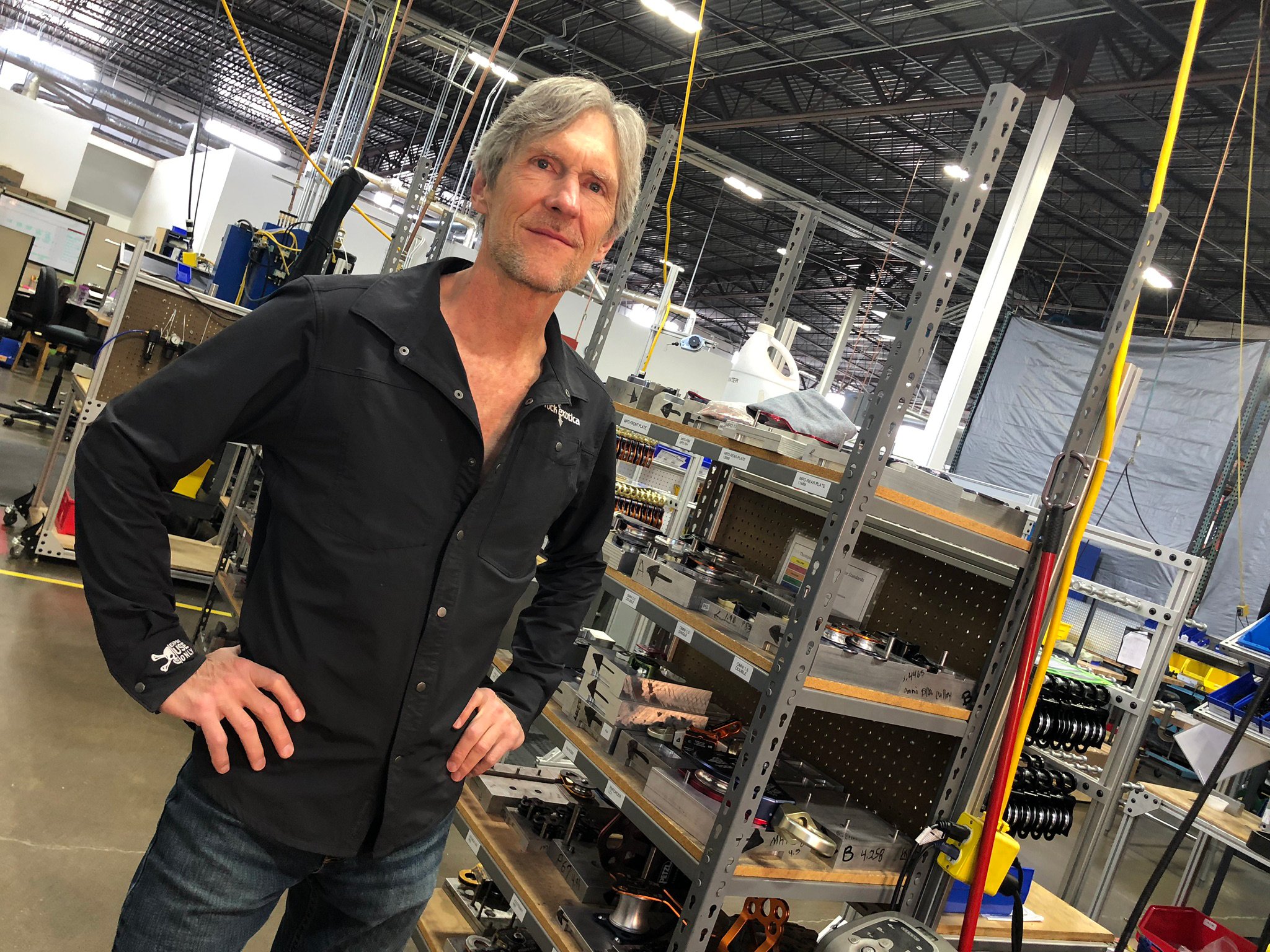An American Success Story: Rock Thompson on Climbing, Inventing, and Building a Business
Roco Chats with the Experts
It’s not often that you meet business people who love their work as passionately as Rock Thompson does. In this post, we talk with Rock, the founder and owner of Rock Exotica, a company that designs and manufactures innovative and high-quality climbing and rescue equipment. As you will hear in Rock’s own words, he enjoys the journey and that yields results that are often very creative and loved by his customers.
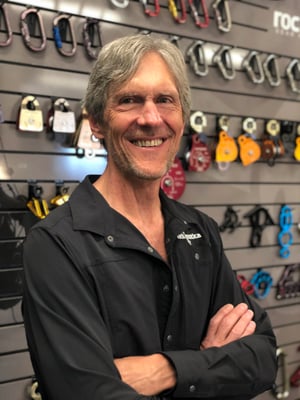 My initial idea for this interview was to discuss how a piece of rescue equipment goes from idea to design and manufacturing, and finally into our gear bags. However, a funny thing happened during the course of this chat. I realized that this story is about so much more than designing and manufacturing equipment.
My initial idea for this interview was to discuss how a piece of rescue equipment goes from idea to design and manufacturing, and finally into our gear bags. However, a funny thing happened during the course of this chat. I realized that this story is about so much more than designing and manufacturing equipment.
Rock’s is a great success story that should be remembered by those who think it is impossible to achieve their goals. How you define or measure “success” has a good deal to say about your ability to find it. More on that later, but right now, let’s hear from Rock.
Pat Furr: I’ve always found the story of Rock Exotica and Thompson Manufacturing Inc. to be an interesting one. Would you please share a little bit about your background and how Rock Exotica came to be?
Rock Thompson: It starts, naturally, with my love for climbing. My old climbing partner from way back became less available after he had kids and his wife didn’t like the idea of him climbing anymore. She is a wonderful person, but I took it as a badge of honor that she thought I was a bad influence. That got me into solo climbing, but the methods weren’t great and the systems were mostly homemade. This got me thinking…there must be a better way to solo climb, and maybe there could be a device that could help.
As a kid, I always liked to make things or find better ways to do things. For
example, I bought an old World War II milling machine that was worn out, but I got it working and I made a prototype that eventually became the Soloist. It looked like a caveman had chipped it out of flint. It had some curves on it, but the mill was not CNC (Computer Numerical Control) so I had to turn the handles at the same time and just approximate what I wanted. It was a lot of fun, and it sort of worked. I refined it some, but eventually, I wanted to make something that looked a little more professional.
I bought a milling machine that was in good condition and also had a rotary table. It worked really well and I thought that maybe I could sell some of these things. I put an ad in Climbing Magazine and paid a lab to do strength tests so I knew it was really strong. I started to sell some Soloists, but it was definitely a niche product. I had stores call me and even REI called me and started carrying it.
PF: So after developing this one niche product, what happened next?
RT: I met some other well-known climbers, including aid climber John Mittendorf. He suggested a device which eventually became the Wall Hauler. People tried it out and they loved it. Larry Arthur, who owns Mountain Tools came to me with the idea that maybe a swivel would reduce the gnarly mess of pigtails in the haul rope while the haul bag spins around and twists the rope. I only sold fifty of them that first year, but when the rescue guys got a hold of the swivel, it really started to do well.
PF: What was your breakthrough product?
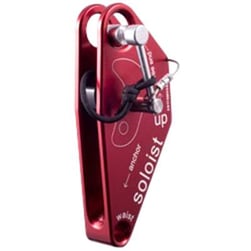 It was after the Rescuecender that I started to think that maybe I could actually start making a living doing this. There was a rescue meeting in Salt Lake and Tom Vines and Steve Hudson called me and wanted to meet with me. I found out they were pretty big deals in the rescue world. They asked me if I could make a rope grab that uses the technology of the Soloist. The Soloist was machined out of solid billet, which is an expensive way of making things, but it is really strong and light. All the current cam devices used a curved cam and a flat plate which would place all the point pressure onto a very small length of the rope and were known for damaging the rope or cutting the sheath. What the Soloist did was clamp the rope over a much longer section. We called that design the curved cam interface. Steve and Tom wanted a rope grab like that and the Rescuecender turned out to be a really good product. Steve’s company PMI (Pigeon Mountain Industries) was carrying my products, so all of a sudden I had a full-time job making stuff and coming up with ideas for new stuff.
It was after the Rescuecender that I started to think that maybe I could actually start making a living doing this. There was a rescue meeting in Salt Lake and Tom Vines and Steve Hudson called me and wanted to meet with me. I found out they were pretty big deals in the rescue world. They asked me if I could make a rope grab that uses the technology of the Soloist. The Soloist was machined out of solid billet, which is an expensive way of making things, but it is really strong and light. All the current cam devices used a curved cam and a flat plate which would place all the point pressure onto a very small length of the rope and were known for damaging the rope or cutting the sheath. What the Soloist did was clamp the rope over a much longer section. We called that design the curved cam interface. Steve and Tom wanted a rope grab like that and the Rescuecender turned out to be a really good product. Steve’s company PMI (Pigeon Mountain Industries) was carrying my products, so all of a sudden I had a full-time job making stuff and coming up with ideas for new stuff.
PF: Yes, you developed a reputation as the “Skunk Works” for innovations in climbing and rescue equipment. Were you a strong math and science student when you were in school or did you just learn about the machining and such as you went along?
RT: I was a good student and yes, I liked math and science. I was lucky because I had great parents that gave me a lot of confidence and made my schooling seem a lot of fun.
PF: A lot of folks aren’t aware of the story of Rock Exotica and TMI and then for lack of a better term the rebirth of Rock Exotica. I find it a very interesting story and it must have been so for you. Could you tell our readers about that journey?
RT: Steve Hudson from PMI was the importer for Petzl and he introduced me to them. Petzl was looking for somebody to make carabiners, as they were not happy with the quality of the carabiners that they were having made for them at the time. They wanted to own their own company to make just carabiners, so we made a business arrangement and thus was the beginning of Thompson Manufacturing Inc. (TMI). Petzl felt that the current designs available from the manufacturers were not right for them. My opinion was that instead of trying to modify any existing designs that it would be better to start from scratch. So we did that, and I had to learn how to make carabiners.
I spent a lot of time up at the University of Utah which has a very extensive patent library. I looked at all the patents, material characteristics, and machines. I went to some trade shows for machinery and had a great time learning that there are CNC machines that are also benders. If you look closely at a carabiner, you will see that the bend has two or three different radii instead of one constant radius. None of the bending companies wanted to make me a bender that could do that. They said ‘we’ve tried that before and we lost our shirt.’ I was really stuck with that, so I just designed my own bender, which we are still using today. We started making really good carabiners and they became very popular.
PF: Your carabiners have the key lock design at the gate. Why did you decide to go with that design?
RT: I had seen this type of carabiner and found the patent. I really wanted to 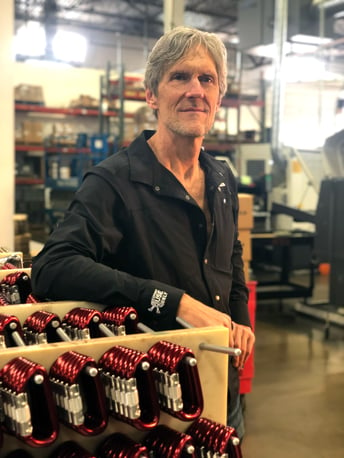 make the best carabiners in the world, and I knew that the key lock design was really good, so we licensed that design for our gate interface. Of course, it is more difficult to make a carabiner that has that interface opposed to more traditional claw or pin latch gates, but once we bought a CNC machining center, we were able to produce them much more efficiently with very high quality for the tolerances required. I made a feeder that would feed the blanks in automatically and clamp the blank. We were able to optimize the strength with the exact clearances so the gate wouldn’t drag on the frame and all kinds of technical things so we ended up with the performance and strength we wanted. We made everything in-house - the frame, the gates, and the sleeves - so we were able to get everything right so that it synchronizes correctly and the sleeve closes when you want it to but not before. This would have been impossible to do if we outsourced the various components from other sources. Because we made everything ourselves, I could change something by 5/1000 of an inch on the fly to really fine-tune it.
make the best carabiners in the world, and I knew that the key lock design was really good, so we licensed that design for our gate interface. Of course, it is more difficult to make a carabiner that has that interface opposed to more traditional claw or pin latch gates, but once we bought a CNC machining center, we were able to produce them much more efficiently with very high quality for the tolerances required. I made a feeder that would feed the blanks in automatically and clamp the blank. We were able to optimize the strength with the exact clearances so the gate wouldn’t drag on the frame and all kinds of technical things so we ended up with the performance and strength we wanted. We made everything in-house - the frame, the gates, and the sleeves - so we were able to get everything right so that it synchronizes correctly and the sleeve closes when you want it to but not before. This would have been impossible to do if we outsourced the various components from other sources. Because we made everything ourselves, I could change something by 5/1000 of an inch on the fly to really fine-tune it.
PF: I have to say that your hardware is consistently jewel-like. For me and many others, the quality of the finish and appearance is often a signal as to the overall quality and performance of the device. So after starting your second company, Thompson Manufacturing and working with Petzl, how did you find yourself in a position to re-energize Rock Exotica, and how has that been going?
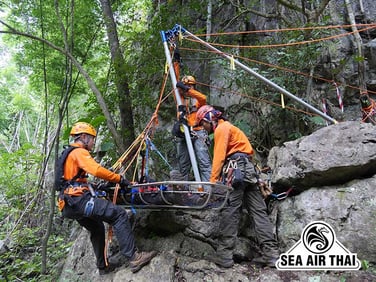 RT: Fantastically! I appreciated the things I learned working with Petzl, but I was ready to get back to designing and making gear on my own and having complete control over what I focus on. Fortunately, people still remembered the Rock Exotica brand and were really interested in it. In the first days of getting it going again, I was really looking for products that I could stay in business with. The first thing we did was the new Vortex. I helped Reed Thorne with the original Vortex design before Petzl. It was popular, but was selling in very small numbers and had some manufacturing issues and some things that needed refining. I knew we could come up with a much better design, so Reed and I totally redesigned it and it became a big hit.
RT: Fantastically! I appreciated the things I learned working with Petzl, but I was ready to get back to designing and making gear on my own and having complete control over what I focus on. Fortunately, people still remembered the Rock Exotica brand and were really interested in it. In the first days of getting it going again, I was really looking for products that I could stay in business with. The first thing we did was the new Vortex. I helped Reed Thorne with the original Vortex design before Petzl. It was popular, but was selling in very small numbers and had some manufacturing issues and some things that needed refining. I knew we could come up with a much better design, so Reed and I totally redesigned it and it became a big hit.
Then we just went on from there.
Another Rock Exotica product that’s done well and I’m really proud of is the carabiner we designed for firefighters. I had been working on an aluminum ladder hook carabiner when the FDNY called me and they asked if I had an aluminum NFPA G-rated carabiner. It was a little premature, but of course, I said, “Yes I do!” So I hurried and finished it over the next few weeks and sent them samples so they could test it in their labs. They loved it because it was much lighter than their previous carabiners. It also had a larger stock, which was a good feature for them, as they would sometimes rappel on it by wrapping the rope around the frame and the larger stock added friction control. Plus we had a different type of sleeve which you pull down and twist which helped reduce the chance of the rope accidentally opening the gate in certain situations. They threw away their steel ones and soon every FDNY firefighter had one of mine on their chest.
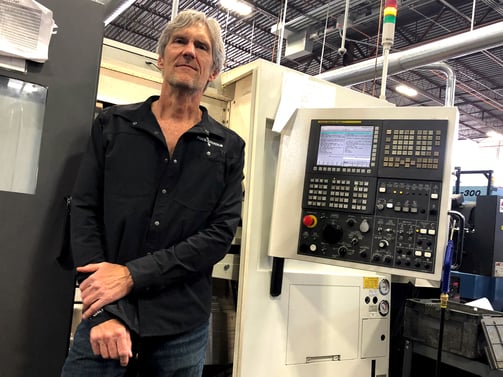
So I was having fun and found myself in a position to buy more CNC machines. The first machines I bought were two horizontal 4-axis machining centers, which allowed me to think about design in a whole different way. I was able to use it for all sorts of products including the carabiner frames. If you look at most of our carabiners you’ll see that there’s an offset built into the frame that allows the gate to fit a larger diameter rope. The 4-axis machine made it possible to do that offset.
PF: Because of your climbing background and your involvement with the climbing and rescue community, you have a real good gauge of the types of products that are required. You already mentioned some of the folks that you have collaborated with in designing gear, but what are some of your favorite designs that you either took a raw idea and ran with or one of your original ideas.
RT: One of my favorites that was a lot of fun even though there was no financial reward. I made a folding grappling hook.
PF: I remember that. You demonstrated it at ITRS around 1999 in Albuquerque.
RT: Yeah people loved it, we took it to trade shows and it was what people wanted to see first. It was cool, but the only problem was not many people actually needed one. It was one of the most intensive uses of lathe and millwork on the CNC machines, so it was a lot of fun, but only fun. It didn’t make much money.
Whereas the Omni-Block is one of my favorite products. A lot of people use our  swivels with pulleys but I thought it would be nice to save that extra length of a carabiner to connect the pulley to the swivel. It was a really fun design because you had to forget about normal pulley design. I became obsessed with designing it and would wake up in the middle of the night with an idea for it. It required that we machine a body that housed the axle, and the button to release the side plate, and a nice thick section to attach the swivel to. It was really fun to design and was perfect for our new 4-axis machines. It became a terrific success and that generated different sizes of the pulley. We now have one with a four-inch sheave, which has over a 30,000-pound breaking strength and is used a lot in material handling. I’m really proud of that product because it is totally different and it has revolutionized the way people are using pulleys.
swivels with pulleys but I thought it would be nice to save that extra length of a carabiner to connect the pulley to the swivel. It was a really fun design because you had to forget about normal pulley design. I became obsessed with designing it and would wake up in the middle of the night with an idea for it. It required that we machine a body that housed the axle, and the button to release the side plate, and a nice thick section to attach the swivel to. It was really fun to design and was perfect for our new 4-axis machines. It became a terrific success and that generated different sizes of the pulley. We now have one with a four-inch sheave, which has over a 30,000-pound breaking strength and is used a lot in material handling. I’m really proud of that product because it is totally different and it has revolutionized the way people are using pulleys.
PF: We use it a lot in our classes and it is so cool to watch our students as they build a Z Rig and are not paying attention to the second and third lines, which inevitably become crossed. But with the Omni-Block, as soon as they pull on the haul line, those twists spin right out completely and the system is clear. It’s freaking magic. It sounds like the quick release side plate was a necessity because you had to build the frame to mount the swivel. I always assumed the quick release side plate was the impetus for your design.
RT: You are exactly right. The integrated swivel required a totally different mechanism to open and close the side plates.
PF: I guess that falls smack into the necessity-is-the-mother-of-invention category.
RT: A lot of people get stuck in the trap of seeing a way of doing things as they are now and don’t stop to think first of what you want the device to be able to do and then design a means to meet that performance. We did the same thing when we re-designed the Vortex. Reed Thorne, the original designer, had some ideas, but frankly, I intentionally asked him not to tell me his design ideas, but I did want to hear from him what he wanted it to be able to do. By distilling it down to what we need it to do, and forgetting about the original design, we were able to meet those objectives.
PF: It seems that just about every device or performance requirement for climbing and rescue gear has seen an incredible advance in terms of performance and weight savings. Do you see this explosion in new technologies finally starting to wane a little bit? Are most all of the good ideas already out there?
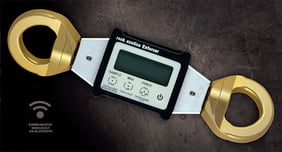 RT: That’s a great question. I would never say that innovation is at an end. There will always be other things we can do and other tools to do them. There are things that we at Rock Exotica have thought of that, for now, we are keeping under wraps. Ten years ago, we never would have thought about the Enforcer but now it is out there and people love that thing.
RT: That’s a great question. I would never say that innovation is at an end. There will always be other things we can do and other tools to do them. There are things that we at Rock Exotica have thought of that, for now, we are keeping under wraps. Ten years ago, we never would have thought about the Enforcer but now it is out there and people love that thing.
PF: You have managed to make your vocation your vacation, and truly love your work. I would like to use you as an example and get up on my soapbox for just a bit. I am starting to have slight concerns that we as a nation are starting to lose our edge in innovation. I know every generation has its challenges and its unique culture, but I hope that our younger students find value in a strong education. And as importantly, get out and experience all the things in this world that will stimulate their creativity in solving problems. You just don’t strike me as that guy in high school who wore a pocket protector.
RT: No, I didn’t, but some of my friends did.
PF: Do you have any personal stories or words that you may want to share with our readers, especially parents, to help them refocus on the importance of their kids' studies in school, especially in math and the sciences?
RT: That is so important now. As an employer, I am well aware of the need for quality employees that not only have an education but also have practical experiences to draw on... I can’t talk enough about the importance of encouraging your children to read. If you read, you can learn anything. We see prospective employees who got through school just to get a job but focus on such a narrow area. For instance, there are engineers who don’t know much about the manufacturing process, so they end up designing products that you can’t actually make. The best engineers are the ones who loved building stuff as a kid. When I find an engineer who knows how to run a milling machine, they’re like gold, they are so rare. I do worry a little bit that although the US still does great, a lot of other nations have moved beyond replicating our innovations and are now becoming innovators themselves.
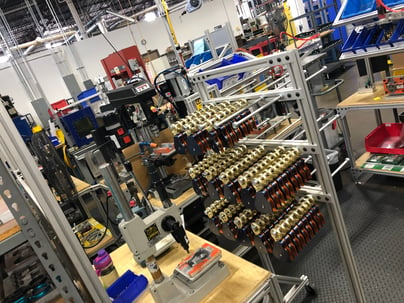 PF: I know we will always have young students that are very strong in math and the sciences, but I feel there is still a huge need to get out and learn about levers, ramps and other tools and such in the physical world.
PF: I know we will always have young students that are very strong in math and the sciences, but I feel there is still a huge need to get out and learn about levers, ramps and other tools and such in the physical world.
RT: I would like the United States to stay on top. I am proud that I make all my stuff here in the US in my own facility. I’ve had numerous chances to manufacture offshore to make my products cheaper. But I don’t care, if it came down to that, I would find something else to do.
And yes we do need to encourage kids to not only study but also to get out and experience all the other things that give them a broad background. I am really happy with how things have worked out for me. I feel I am successful for sure, but the most important measure of that success for me is I am having fun doing what I do. Of course, it required a lot of support from my family, employees and of course my wife who is endlessly indulgent. I’ve gotten the look from her now and then.
PF: Thanks so much Rock. This has been a lot of fun. Ok, there we go. I guess I am successful too because this is my job and I just admitted to having fun doing it.
